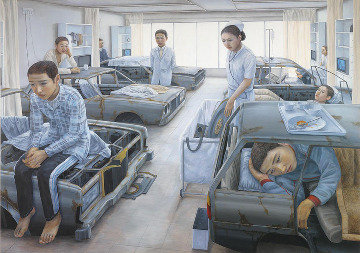Tetsuya Ishida
dal 6/11/2013 al 20/12/2013
Segnalato da
6/11/2013
Tetsuya Ishida
Gagosian Gallery, Hong Kong
The artist's first exhibition outside Japan and the gallery's first presentation of his work. In nightmarish scenes, suited figures made in his own likeness but possessing machine or animal parts are depicted being boxed and repaired, like helpless objects.

At first, it was a self-portrait. I tried to make myself—my weak self, my pitiful self, my anxious
self—into a joke or something funny that could be laughed at...It was sometimes seen as a
parody or satire referring to contemporary people. As I continued to think about this, I expanded
it to include consumers, city-dwellers, workers, and the Japanese people.
—Tetsuya Ishida
Gagosian Hong Kong is pleased to announce an exhibition of paintings by Tetsuya Ishida, the
gallery’s first presentation of his work. This is the first exhibition of Ishida’s paintings outside of
Japan.
Ishida came of age as a painter during Japan’s “lost decade,” a time of nationwide economic
recession that lasted through the 1990s. In his afflictive paintings, he captured the feelings of
hopelessness, claustrophobia, and emotional isolation that burdened him and dominated
Japanese society. From his early career until his untimely death in 2005, Ishida provided vivid
allegories of the challenges to Japanese life and morale in paintings and graphic works charged
with dark Orwellian absurdity.
In nightmarish scenes, suited figures made in Ishida's own likeness but possessing machine or
animal parts are depicted being boxed and repaired, like helpless objects. Foreground and
background are rendered in equally meticulous detail and this intricate compression of layers
intensifies the sense of entrapment. The stoic male subjects seem accustomed to their cyborg
limbs and dreary surroundings as they carry on in their shared routine. Some men are fully
merged with household objects, reduced to little more than functional but inanimate tools and
furniture.
Waiting for a Chance (1999) depicts young men in a hospital room, anxiously awaiting their fate
as they rest on scrapped auto bodies in place of hospital beds. The striking allegory Descendant
(1999), also set in a hospital, portrays a group of surgeons surrounding a child who has been
birthed by prehistoric reptiles. In Exercise Equipment (1997), a recurring suited subject is
pictured running on a treadmill, monitored by men positioned to hook his ankles should he slow
down. These disturbing scenes are consistent with the surreal melancholy of contemporary
Japanese authors such as Mahoko Yoshimoto and Haruki Murakami, whose novels propose a
society of individuals debilitated by neurosis and traumatic dysfunction.
Tetsuya Ishida was born in Yaizu, Shizuoka, Japan in 1973, and died in Tokyo in 2005. Solo
museum exhibitions include Sumpu Museum, Shizuoka, Japan (2006); “Tetsuya Ishida: Canvas of
Sadness,” Shizuoka Prefectural Museum of Art (2007); CB Collection, Tokyo (2007); and “Tetsuya
Ishida: Self-portraits,” Nerima Art Museum, Tokyo (2008). Selected group exhibitions include
“Asian Avant-garde,” Christie’s London (1998); “dis-communication,” Sungkok Art Museum, Seoul
(2007); “Chaosmos ‘07: In the Face of Sadness,” Sakura City Museum of Art, Chiba, Japan (2007);
and “Tetsuya Ishida and Shizuoka-related Artists,” Hamamatsu Municipal Museum of Art,
Shizuoka (2009). A survey exhibition of Ishida’s work, “Notes, Evidence of Dreams,” was on view
at Ashikaga Museum of Art this fall, and will travel to Hiratsuka Museum of Art; Tonami Art
Museum, Toyama; and Shizuoka Prefectural Museum of Art (through 2014).
Opening Thursday 7 November 2013, 18 - 20
Gagosian Gallery
7/F Pedder Building, 12 Pedder Street, Hong Kong
Hours from Tuesday to Saturday, 11 - 19
Free entrance



